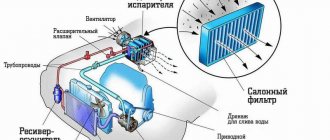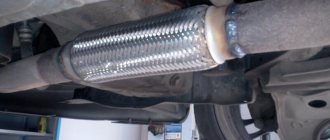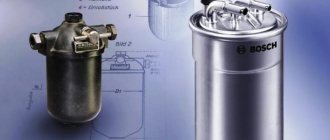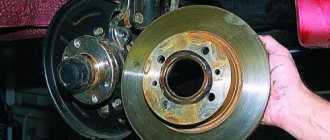The system for maintaining the desired temperature in the car interior is so familiar to most car owners that few people think about how it all began. The first attempt to cool the passengers tired of the heat was the simplest cabin ventilation. Remember the corner vents on old cars that turn at an angle like air intakes? With the windows open wide, a stream of air rushed into the interior of a moving car and gave coolness to the car owner and his companions, along with dust, noise and the possibility of catching a cold from the draft. Moreover, such a system did not work when it was needed most - in parking lots and in traffic jams under the scorching sun.
Therefore, already in the now distant 30s of the XX century. In America, the country of triumphant comfort, the most expensive and “sophisticated” cars of the limousine class are beginning to be optionally equipped with an air cooling system in the cabin - the size of half a trunk, without adjustments, and taking up to half the power of the engine operating at low speeds. In Europe, until the 80s, they didn’t even think much about cars with air conditioning.
Today, only budget car lines are not equipped with air conditioning as standard. For all other cases, the air cooling system in the cabin is the norm. In addition to standard air conditioning, many automakers equip their vehicles with climate control. Every car owner should know the differences between climate control and air conditioning in a car and what the features of each system are, because this will help to operate these units correctly and for a long time without breakdowns.
Historical summary
Initially, cars were equipped exclusively with air conditioning systems. The first such systems appeared on cars around the 1940s. They were very expensive, so they were in little demand. More modern solutions began to be used approximately 15 years later. So, in 1954, a universal heating and ventilation system appeared on Nash-Kelvinator models, which included a heater and air conditioner. Already in the early 60s, about 20% of American cars were equipped with air conditioning. Over time, this unit was modernized, as a result of which these systems received many new functions.
What is the difference between climate control and air conditioning? First let's find out how they work. Note that these are completely different concepts that are simply confused. Both systems are designed to make vehicle operation more comfortable. But there are also significant differences between air conditioning and climate control. Let's start with the first one, because he was the debutant.
Air conditioner
The first air conditioners appeared a long time ago. Naturally, they were less perfect than they are now. However, their popularity was just as great. The operating principle of an air conditioner is quite simple. It has a compressor and refrigerant. A special pump pumps the refrigerant, which is in a gaseous state, through the entire system under pressure. It first passes through the condenser, where it cools and takes on liquid form, then it enters the evaporator. There is a special fan installed there that drives air out of the room, replacing it with cooled air.
Air conditioners in apartments not only cool the air, but also clean it through special filters. As a result of using an air conditioner, you can be sure that you are breathing clean and fresh air.
One of the disadvantages is the fact that when air is passed through a fan, this device dries it out very much. And this is quite harmful both for the mucous membranes of the human body and for his breathing. Therefore, it is advisable to drink more in an apartment with a working air conditioner and additionally moisturize your face and eyes, as well as use a humidifier.
Air conditioning in a car
The car air conditioner is connected to the crankshaft using a belt drive, this solution ensures its rotation and normal operation. In fact, the system constantly operates at full power, and the flow of cold air is regulated only by selecting the speed of the fan in the cabin. The higher the speed, the faster the air inside the car will cool.
The key difference between an air conditioner and climate control is that it only “can” cool the air inside the car, and is controlled manually.
Note that the operating principle of a car air conditioning system involves taking air, drying it and sending it into the cabin.
How does an air conditioner work?
Since its inception, the physical basis of the performance of cooling machines has not undergone significant changes. This is the basis - the ability of substances to absorb or release accumulated heat during the transition from one state of aggregation to another (that is, during evaporation and condensation). The air conditioner is not the only device in the car that works on this principle. The engine cooling system through a radiator is another example where ordinary water was previously used as a coolant, but now antifreeze or antifreeze is used.
Nowadays, air conditioning is a mandatory function and is equipped even in cars with minimal equipment.
In air conditioning units, the coolant is called refrigerant. Currently, these are various brands of freons - special hydrocarbons with the required boiling and condensation points. In addition to the refrigerant, special grades of oil circulate in the cooling circuit. It ensures long-term and uninterrupted operation of rubbing and moving mechanisms. These parts are located mainly in the compressor. Oil and refrigerant are in a mixture state, so if there is a leak, not only does the pressure and efficiency drop, but the safety of the mechanisms also decreases.
Compressor
The most important part that ensures the functionality of the cooling device. It combines two functions. Firstly, it is a pump that ensures that freon, in a liquid or gaseous state, is pumped through all pipelines. Secondly, pressure is created inside the compressor, which thickens the freon vapor coming from the evaporator. Under the influence of pressure, gas turns into liquid with a simultaneous change in temperature characteristics.
General view of the air conditioning compressor
The compressor is driven by power take-off from the crankshaft through a drive belt. When operating an air conditioner, an average of 5 to 15 liters is spent. pp., so if the engine lacks power under load, turning on cold air will only worsen the situation. There is additionally an electromagnetic clutch between the pulley and the compressor rotor - it disconnects the compressor motor when it needs to be turned off.
The compressor performs an important task - it separates the high and low pressure circuits of liquid and gas. The first is called a pressure system, the second is called a suction system.
Capacitor
You may come across the name “condenser”, but this does not change the essence of the matter. It looks like a car radiator and is located there. In the radiator, the freon, condensed in the compressor and thus becoming hot, must cool down. Therefore, manufacturers try to place the capacitor as close to the front edge as possible, behind the radiator grille. Here, the incoming air flow during movement helps in cooling. The condenser also has its own fan, or even a pair of fans - to quickly achieve the effect. True, there is also the other side of the coin. Being in front, the condenser gradually becomes clogged with road dust and dirt, debris, and insects. Over time, this can worsen heat transfer, so the car owner needs to periodically check its condition and clean it mechanically. This will help extend the life of the system and increase the decreased efficiency.
The air conditioning condenser is located in front of the radiator under the hood
Drying filter
This element does not ensure the physics of the cooling process, but contributes to its quality and uninterrupted operation. The fact is that freon accumulates moisture, which has other evaporation and condensation parameters, and therefore interferes with the main function of the air conditioner. In addition, moisture has a more aggressive effect on metal parts and promotes corrosion. Drying the refrigerant returns it to its original state. Well, filtration allows you to remove from the coolant mechanical inclusions that got there during operation - dust, dirt, small debris.
Expansion valve
Its second name is thermostatic valve. The freon coming from the filter drier is supplied in metered portions from the expansion valve to the evaporator. When passing through the valve, the refrigerant changes from a liquid to a gaseous state, but not completely. At this stage, freon is a suspension of gas and fine liquid. You can observe a similar condition when you spray something from an aerosol can. Sometimes a special peephole is installed on the expansion valve to visually monitor the amount of coolant in the system.
Article on the topic: The engine takes oil, but does not smoke: why does this happen?
The main function of the expansion valve is to relieve internal stress in front of the evaporator, which will lead to its cooling
Evaporator
This is the same radiator, only working in reverse. If in a radiator atmospheric air cools the hot liquid inside, then in the evaporator the incoming cold freon in a gas-liquid state cools the surrounding space. To do this, a fan works in tandem with the evaporator, which drives the cabin air through the evaporator and cools it. Drum-type fan, as in stationary room split systems. The evaporator is usually not very large.
To ensure proper operation of the air conditioner, it is recommended to clean the evaporator at least once every 2-3 years.
Piping and sensor system
The air conditioner wiring is represented by tubes made of copper or copper alloys. They form a freon route from the condenser to the evaporator through the compressor. From the compressor and condenser they are thin and hot, and the return circuit from the evaporator back to the compressor is larger and cold. The air conditioner also includes a moisture collection system, which condenses on the surface of the evaporator. The collected water is drained directly under the bottom of the car. This is the reason for the appearance of puddles under a car in which the air conditioner was running in the parking lot. The cooling device also has several sensors that correlate the operating mode of the air conditioner elements with the specified temperature parameters.
Sequence of work
When you press the button on the instrument panel, the compressor starts. Since the pulley is driven by the rotation of the crankshaft, starting is possible only when the engine is running. The electric coupling connects the pulley to the compressor mechanism, and it begins to drive the refrigerant through the system, simultaneously compressing it. Hot freon enters the condenser, where it not only cools, but also completely turns into a liquid state and condenses. Blowing outside air with a fan and the force of the oncoming flow speeds up this process. The refrigerant passes through a filter drier where it is cleaned and gets rid of moisture. When passing through the expansion valve, the pressure in the system drops sharply, and the liquid becomes an aerosol. As a result of this transition, freon begins to boil, that is, it turns into a gaseous state and becomes cold. Being fed into the evaporator, it lowers its temperature. The air blown through the evaporator by a fan is supplied to the cabin through special ventilation holes. Giving up the cold in the evaporator, freon in a gaseous state goes through the return circuit to the compressor, where the cycle closes. When the desired temperature in the cabin is reached, the sensor sends a signal to turn off the fluid coupling, and the air conditioner “rests” for a while.
The operating principle of a car air conditioner is similar to the operation of a home air conditioner or refrigerator.
Video: how the air conditioner works
Climate control
What's the difference between climate control? Such a system contains the following additional elements:
- electronic control unit in the cabin;
- temperature sensors.
Climate control is capable of independently maintaining a user-specified temperature in the cabin. This is a much more “smart” development that itself controls the operation of the air conditioner, as well as heating and ventilation systems. The presence of an electronic control unit makes the ride much more comfortable. Owners of cars with such a climate system do not need to be distracted from the road to select the optimal heating or cooling mode.
The control unit collects data from various sensors inside and outside the vehicle. After this, he analyzes the information received and determines what actions need to be taken to meet the needs of the driver and passengers. Another advantage of climate control is reduced fuel consumption. Don't forget that turning on the air conditioning increases fuel consumption by about 1-2 liters per 100 km. In cars with air conditioning, it works constantly, but climate control can use the compressor only when necessary. This significantly affects fuel consumption.
Another advantage of climate control over air conditioning is the ability to autonomously control the dampers in winter. The system analyzes data on the temperature outside and inside the car, and then regulates the operation of the air dampers. Initially, the air flow is directed onto the windshield, which helps to defrost it. The footwells of the driver and front passenger are then heated. Only after this does warm air begin to flow onto your face. True, not all cars have such “smart” developments.
Recommendations for the cold season
The operating algorithm of the device described above is of a general nature. In fact, each manufacturer creates a system for a specific series or model. For this reason, the controller software may differ slightly.
Car owners often think that since the temperature inside the car is set at a comfortable temperature, there is no point in wearing warm winter shoes. However, if snow falls unexpectedly, you will have to spend some time near the car, trying to clear the area around it from snowdrifts. If you don’t have time to return home and change your shoes, the right solution would be to use manual climate control and switch to the foot blower mode.
Another common situation is being stuck in traffic jams during the cold season. They are caused by snow and ice. In addition to protection from bad weather, it is also important to avoid the penetration of exhaust gases into the car interior. At such moments, the recirculation mode will come in handy. Modern modifications produced today have the option of collecting carbon dioxide from the surrounding space and its subsequent analysis.
If you leave your car in an open area, the windows may become coated with ice. Not all air conditioning systems have automatic heating. A situation may also arise when the preset heating time was not enough to melt the ice on the glass. In such a situation, you will have to turn off the auto mode and switch to manual glass blowing. You will also have to select the appropriate fan speed at this moment. As soon as you manage to cope with the ice crust, you can re-set the automatic mode.
Climate control and air conditioning control
The air conditioner can only be controlled manually. Usually, a separate button labeled A/C is installed on the center console (another option is the “snowflake” icon). This button is responsible for turning on the air conditioner. The choice of the most suitable air flow temperature is regulated using “knobs” or other similar elements.
If you own a car with climate control, driving will be much more convenient. You just need to set the optimal air temperature inside the car, and the installation will do the rest for you. The “Auto” function is also available, the activation of which involves automatic selection of the optimal temperature by the control unit.
The principle of operation of a car air conditioner
According to the principle of operation, an air conditioner is in many ways similar to a regular household refrigerator, although their internal structure is different. True, even within the automotive industry, car air conditioners may differ in design, but the meaning of their operation remains unchanged. In any case, this is a closed, sealed system through which freon circulates. It needs to be changed periodically, which can only be done at a service station.
When a person presses the start button of a mechanical air conditioner, the corresponding electromagnetic clutch is activated, and with the help of the pressure disk of the drive unit, the pulley is connected to the air conditioning system. At the same time, the pulley is in motion all the time and, thanks to a belt drive, rotates from the crankshaft.
Then the compressor comes into action, whose task is to compress the gaseous freon, due to which the latter heats up and enters the condenser (the so-called “radiator” of the air conditioner). Here the hot freon is cooled using an electric fan, which by default operates at first speed.
As the vehicle drives, the cooling effect increases, but if the vehicle is stationary, for example in a traffic jam, sensors are able to detect a decrease in the efficiency of the air conditioning system and initiate the start of a second fan speed.
After cooling in the condenser, the freon condenses and becomes liquid. Then, in the receiver-dryer, the composition is filtered from debris, and the freon begins to move towards the car’s interior. The main action takes place when it enters the evaporator through the thermostatic valve. Here the substance boils and becomes steam, greatly reducing the temperature of the evaporator. Then, using a separate fan, cool air is forced into the vehicle interior. After this, the freon returns to the compressor, where a new heat exchange cycle begins.
Types of climate control
During the development of climate systems for cars, manufacturers significantly modernized them and made them even more convenient. Modern installations can maintain different temperatures in separate areas of the car. For this, as you may have guessed, several temperature sensors are used. Most often, modern cars are equipped with dual-zone climate control.
On budget cars there is a single-zone option. Premium models are available with an air conditioning system that allows you to regulate the air temperature in three and four zones separately. This is very convenient, since each person is used to regulating the temperature in his own way. For example, dual-zone climate control allows the driver and front passenger to select individual temperature settings.
Car air conditioning and health
Of course, we all enjoy sitting in a warm cabin in winter, and hiding from the heat in summer by turning the air conditioning to maximum. But if you use the climate system ineptly, you can seriously harm yourself.
Too much temperature difference between the cabin and outside is an easy way to catch a cold. To avoid problems, experts advise that this difference should be no more than 5 degrees. Of course, if we talk about traveling long distances, this interval can be increased, but this must be done gradually.
A fly in the ointment
There is no doubt that air conditioning and climate control, although they have some differences from each other, significantly increase the operating comfort of a car. But there are some drawbacks here too. Automatic systems, although more convenient to use, require more expensive maintenance. And in the event of a breakdown, you will have to look for a good specialist.
The disadvantage of climate control is its higher cost compared to air conditioning. Such a system includes additional sensors and electronics, and all this periodically fails. Of course, if we talk about buying a new car, then no one thinks about repairing the climate control, but if you are choosing a used car, then you should take this nuance into account.
Advantages and disadvantages
The equipment system has the following advantages:
- constantly maintains a certain level of ionization, humidity and other parameters;
- works according to schedule. This will allow, for example, to lower the temperature in the rooms at night and raise it in the morning for a pleasant awakening;
- Autonomous and does not require daily setup;
- controlled remotely. You can configure the necessary settings while going home from work;
- prevents the occurrence of emergency situations due to timely notification of the owner, and in some cases, by calling special services;
- assumes the presence of zones with different climates;
- helps you save on utility bills.
Despite the many advantages, we should not forget about the price of the equipment, which sometimes seems high. But it will pay off in energy savings and the comfort provided to the owner and his family. This is possible thanks to the coordinated operation of appliances in all rooms. For example, at a given optimal temperature of +20 degrees, the heated floor is turned on first. If its heating is not enough, the heating radiators or air conditioning will turn on in the apartment. In addition, manufacturers provide a mini weather station complete with smart climate equipment. It monitors the following environmental parameters:
- temperature;
- wind direction and speed;
- humidity;
Advantages and disadvantages of the climate control system
- atmospheric pressure;
- probability of precipitation;
- illumination level.
Choice of winner – climate control or air conditioning
We decided to consider the most important parameters:
- Comfort. According to this indicator, climate control is the undoubted leader. The driver of such a car does not need to be distracted from driving - once you set the temperature and you don’t think about it anymore. With air conditioning, things are not so smooth.
- Economical. It’s difficult to answer unequivocally here, since climate control saves fuel, but in case of a breakdown you will have to spend money. The air conditioner is not so economical during operation, but if it fails, it is more repairable.
- Speed. Climate control wins in this category, since it very quickly responds to any changes in temperature and makes appropriate adjustments. And the air conditioner will have to be adjusted manually.
Based on the main points in this article, we recommend choosing a car with climate control. In most cases, such a purchase will meet your expectations.










